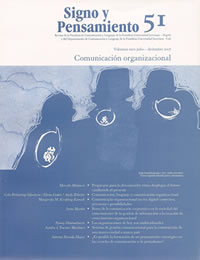Resumo
A comunicação eficaz é um dos maiores desafios que organizações e empresas têm hoje tanto nível nacional e internacional (global). Este artigo apresenta os resultados da pesquisa realizada por uma equipe internacional de pesquisadores interessados na descoberta e comparação de comportamentos comunicativos o estilos de comunicação dos funcionários finlandeses e mexicanos quando interagem com seus superiores.
Aragon, A. M. & Phillips, D. D. (1995). Communication skills of Hispanic leaders. Paper presented at the Western States Communication Association, Portland, OR.
Chen, G. M. y Chung, J. (1994), “The impact of Confucianism on organizational communication”, en Communication Quarterly, núm. 42, pp. 93-105.
Condon, J. C. (1985), Good neighbors. Communicating with the Mexicans, Yarmouth (Maine), Intercultural Press Inc.
Cox, T. Jr. (1993), Cultural diversity in organizations, San Francisco, Berrett-Koehler.
De la Cerda, J. y Núñez, F. (1993). La administración en desarrollo. Problemas y avances de la administración en México. Instituto Internacional de Capacitación y Estudios Empresariales, A.C.: México.
Hall, E. T. (1959), The silent language, New York, Doubleday & Company.
Harris, Ph. R. y Moran, R. T. (1987), Managing cultural differences, 4th ed., Houston, Gulf
Publishing Company.
Hecht, M. (1978), “The conceptualization and measurement of interpersonal communication
and satisfaction”, en Human Communication Research, núm. 4, pp. 253-264.
Hofstede, G. (1980), Cultural’s consequences. Internal differences in work-related values, Beverly Hills, Sage Publications.
— (1984), Culture’s consequences (abridged edition), Newbury Park, Sage Publications.
Hofstede, G. (1991), Cultures and organizations. Software of the mind, London, McGraw-
Hill.
Jones, E.; Watson, B.; Gardner, J. y Gallois, C. (2004), “Organizational communication.
Challenges for the new century”, en Journal of Communication, núm. 4, pp. 722-750.
Kras, E. S. (1988), Management in two cultures. Bridging the gap between U.S. and Mexican managers, Yarmouth (Maine), Intercultural Press.
Kreps, G. L. y Kunimoto, E. N. (1994), Effective communication in multicultural health care settings, Thousand Oaks, Sage Publications.
Martínez, S. y Dorfman, P. (1998), “The Mexican entrepreneur. An ethnographic study of the Mexican empresario”, en International Studies of Management & Organization, núm. 2, pp. 97-124.
Muller, H. J. y Rowell, M. (1997), “Mexican women managers. An emerging profile”, en
Human Resource Management, vol. 36, núm. 4, pp. 423-435.
Nicholls, Ch.; Lane, H. y Brechu, M. (1999), “Taking self-managed teams to México”, en The Academy of Management Executive, núm. 3, pp. 15-25.
Norton, R. (1978), “Foundation of a Communicator style construct”, en Human Communication Research, núm. 4, pp. 99-112.
— (1983), Communicator style. Theory, applications, and measures, Newbury Park, Sage
Publications.
Palacios, L. (1999), “Construcción de una cultura hegemónica en la gran industria regiomontana, 918-1954” [en línea], disponible en: http://mezcal.colmex.mx/historiadores/
ponencias/162.pdf
Sajavaara, K. y Lehtonen, J. (1997), “The silent Finn revisited”, in Jaworski, A. Silence: interdisciplinary perspectives, Berlin, Mouton Gruyter.
Sallinen-Kuparinen, A. (1987), “Culture and communication image” [paper], The Western
Speech Communication Association Convention, Salt Lake City.
Shuter, R. y Wiseman, R. L. (1994), “Communication in multicultural organizations. Conceptual, theoretical, and practical issues”, en Wiseman, R. L. y Shuter, R. (edits.), Communicating in multicultural organizations, Thousand Oaks, Sage Publications, pp. 3- 11.
Teboul, J. C. B.; Chen, L. y Fritz, L. M. (1994), “Intercultural organizational ommunication
research in multinational organizations”, en Wiseman, R. L. y Shuter, R. (edits.), Communicating in multicultural organizations, Thousand Oaks, Sage Publications, pp. 12-29.
Trompenaars, F. y Hampden-Turner, C. (1998), Riding the waves of culture. Understanding
diversity in global business, New York, McGraw-Hill.
Vaahterikko-Mejía, P. (2001), Cultural differences in Ibero-Nordic communication. Perceptions about Finnish and Colombian negotiators [en línea], Jyväskylä, University of Jyväskylä, disponible en: http://selene.lib.jyu.fi:8080/vaitos/studies/studcomm/9513914224.pdf
— (2007), “The meaning of intangibles in international business negotiations finnish negotiating with Latin-Americans” [en línea],disponible en: http://www.jyu.fi/erillis/
agoracenter/en/research/soca/projects/ojala
Varona, F. (1995, november), “Similarities and differences on employee/supervisor communication styles between Hispanics and Euroamericans” [paper], The Speech Communication Association Convention, San Antonio, Texas.
Yum, J. O. (1988). The impact of Confucianism on interpersonal relationships and communication patterns in East Asia. Communication Monographs, 55, 374-388.

Este trabalho está licenciado sob uma licença Creative Commons Attribution 4.0 International License.
Copyright (c) 2021 Federico Varona


